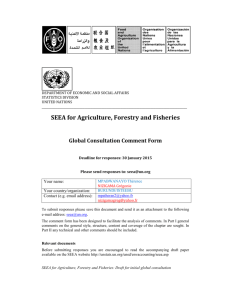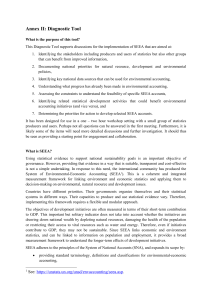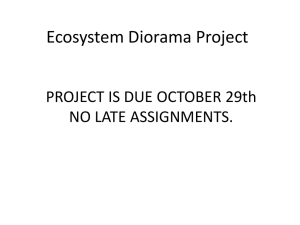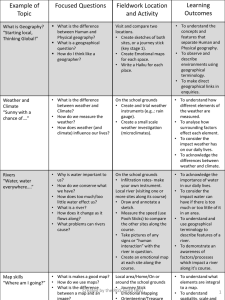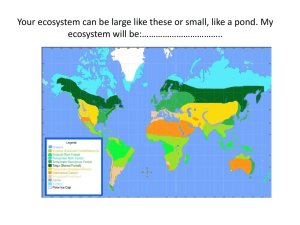The UN System of Environmental
advertisement
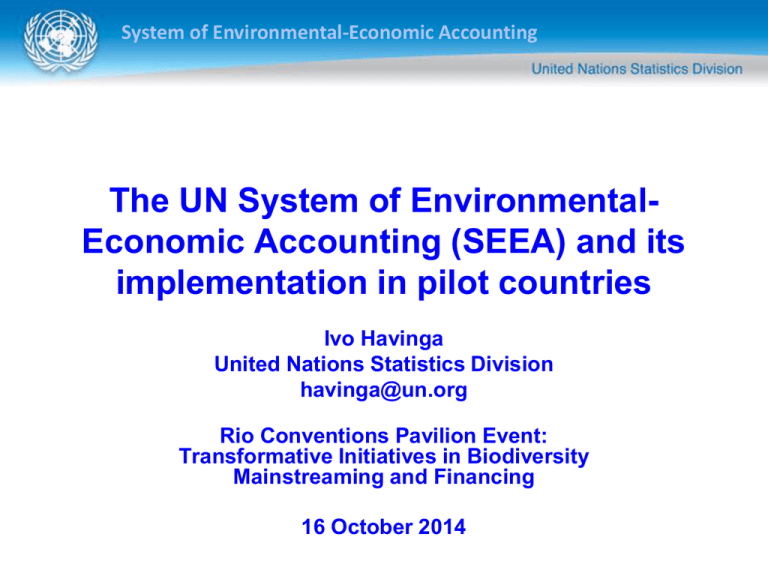
System of Environmental-Economic Accounting The UN System of EnvironmentalEconomic Accounting (SEEA) and its implementation in pilot countries Ivo Havinga United Nations Statistics Division havinga@un.org Rio Conventions Pavilion Event: Transformative Initiatives in Biodiversity Mainstreaming and Financing 16 October 2014 System of Environmental-Economic Accounting Policy Demand: International Context Agenda 21 Rio+20 outcome document High-Level Panel Report on the Post-2015 Development Agenda SDGs monitoring European legislation Aichi targets Natural Capital Accounting International initiatives • OECD’s Green Growth Strategy, WAVES, VANTAGE, UNEPled Green Economy programme, CBD, TEEB System of Environmental-Economic Accounting Integrated multi-dimensional statistics Demand for Integrated statistics which allow coherent understanding for integrated policy Requires accounting approach and integrated statistical production process Ensure quality of information and consistency between basic data, accounts and tables and indicators Indicators Accounts SEEA Basic data Economic Environmental Social Statistics System of Environmental-Economic Accounting Integrated multi-dimensional statistics Transforming sectoral data into integrated policy-relevant information Interrelations between economy, environment and society through systems approach – SNA and SEEA Communication and visualization of the story the statistics tell System of Environmental-Economic Accounting SEEA: Enabler for the transformative agenda SNA SEEA Central Framework SEEA Experimental Ecosystem Accounting Enable integration of biophysical data, monitoring changes in ecosystem and linking those changes to economic and human activity Inform post 2015 development agenda and SDGs Enable partnership at international, regional, sub-regional and national level. System of Environmental-Economic Accounting SEEA Conceptual Framework Territory of reference Environment Imports/Exports Outside territory of reference Economic Units -Enterprises -Households -Government -Non-profit institutions Natural inputs Ecosystem services Economy Activities -Production -Consumption -Accumulation Instruments -Financial/Monetary -Taxes/subsidies - Financing -Resource rent -Permits Analytical and Policy Frameworks -Productivity analysis -Natural resource management -Climate change -Green Growth/Green Economy -Post-2015 Development Agenda Residuals (e.g., emissions, waste) Individual Environmental Assets (e.g., land, water, mineral and energy, soil, aquatic) Ecosystem Assets Transboundary Environmental Flows Outside territory of reference System of Environmental-Economic Accounting SEEA Central Framework Internationally agreed statistical framework to measure environment and its interactions with economy Adopted as international statistical standard by UN Statistical Commission in 2012 Developed through intergovernmental process Published by UN, EU, FAO, IMF, OECD, WB System of Environmental-Economic Accounting The SEEA Central Framework Accounts 1. Flow accounts: supply and use tables for products, natural inputs and residuals (e.g. waste, wastewater) generated by economic activities. • physical (e.g. m2 of water) and/or monetary values (e.g. permits to access water, cost of wastewater treatment, etc.) 2. Stock accounts for environmental assets: natural resources and land • physical (e.g. fish stocks and changes in stocks) and/or monetary values (e.g. value of natural capital, depletion) 3. Activity / purpose accounts that explicitly identify environmental transactions already existing in the SNA. • e.g. Environmental Protection Expenditure (EPE) accounts, environmental taxes and subsidies 4. Combined physical and monetary accounts that bring together physical and monetary information for derivation indicators, including depletion adjusted aggregates System of Environmental-Economic Accounting System of Environmental-Economic Accounting System of Environmental-Economic Accounting SEEA Experimental Ecosystem Accounting Complements SEEA Central Framework Integrated statistical framework for accounting for ecosystem assets and associated ecosystem services Important first step in development of statistical framework for ecosystem accounting System of Environmental-Economic Accounting Linking ecosystem assets and wellbeing through ecosystem services Individual & societal well-being Benefits SNA & non-SNA Human inputs (e.g. labour, produced assets) Ecosystem services Ecosystem processes Ecosystem characteristics Intra-ecosystem flows ECOSYSTEM ASSET Inter-ecosystem flows System of Environmental-Economic Accounting Relationship to SEEA Central Framework Extends range of flows related to regulatory and cultural services (production boundary) for accounting compared to SNA and SEEA CF in physical and monetary terms Many flows from Central Framework also included in Experimental Ecosystem Accounting (e.g. flows of timber), but extension of EEA is to attribute flows to spatial areas Some Central Framework natural input flows are excluded from Experimental Ecosystem Accounting (e.g. mineral and energy resources) System of Environmental-Economic Accounting Approach for developing SEEA Experimental Ecosystem Accounting • Land Cover Accounting 1 2 • Land Use Accounting 3 • Framing the Measurement of Ecosystem Conditions 4 • Carbon Stock Accounting 5 • Biodiversity Stock Accounting 6 • Water Stock Accounting 7 • Accounting for Ecosystem Services 8 • Integrating Ecosystem Accounting with National Accounts System of Environmental-Economic Accounting The SEEA Experimental Ecosystem Accounting brings in two new dimensions: 1. Spatial characteristics expressed in spatial units 2. Integrated or holistic view of multiple characteristics for each unit Minimum dataset scheme Unifying themes • • • • • • • • Land Water Carbon Biodiversity Nutrients Pollution Human activities Ecosystem services Image source: http://www.waterencyclopedia.com/La-Mi/Land-Use-Planning.html The EEA is focused on living (renewable) natural resources System of Environmental-Economic Accounting Spatial data perspective: harmonizing reporting units Measurement units for social, economic and environmental parameters remain untouched New accounting and reporting units created for ecosystem accounting purposes Overlay of units (UK) System of Environmental-Economic Accounting SEEA-EEA integration framework Integration of ecosystem services in macroeconomic aggregates, like GDP and NDP Amenity Risks Ecosystem services in monetary and physical terms Land account Consistent physical and monetary asset accounts Raw data collection, processing and harmonization Land cover/use Accounting units Administrative reg., habitats, ecoregions System of Environmental-Economic Accounting Hierarchical (nested-grid) aggregation Country State Ecosystem Accounting Unit (EAU) Region Statistical Areas Land Cover/Ecosystem Functional Unit (LCEU) Parcel Grid cell (e.g. 20m x 20m or 100m x 100m) Basic Spatial Unit (BSU) 18 System of Environmental-Economic Accounting Geography Building analytical capability for units and ensure that GIS standards are maintained Accounting e.g. unified and hierarchical classifications and variables for units (grid) System of Environmental-Economic Accounting Asset accounts on carbon: Theme unifying a number of components, processes and data sets: Statistical data on: 1. Forest biomass (FRA, 2000, 2005, 2010) 2. Crops harvest (EUROSTAT 2000 – 2010) 3. Timber harvest (EUROSTAT 2000 – 2010) 4. Livestock (EUROSTAT 2000 – 2010) GPP Imports TER Exports Remote sensing products: 1. Land cover (CORINE LC 2000, 2006) 2. Vegetation (SPOT vegetation NDVI 1999 – 2010) 3. Primary production (GPP) and Ecosystem respiration (TER), (NASA, 2000 – 2010) Modelled data: 1. Soil organic carbon (Global map, JRC (Hiederer and Köchy, 2012) Source: European Environment Agency and ETC-SIA System of Environmental-Economic Accounting European carbon accounts The two basic balancing items are designed to summarize ‘vertical’ and ‘horizontal’ carbon transfers Net ecosystem production = Gross Primary Production – Terrestrial Ecosystem Respiration Balance of lateral imports and exports = Carbon returns – carbon ‘uses’ System of Environmental-Economic Accounting Examples: Net ecosystem carbon balance • On country level the ecosystem carbon accounts should be consistent with IPCC’s in assessing whether ecosystems acted as net source or sink of CO2 for a given period of time. • The maps shows a decade average, with areas in green indicating prevailing sink (most of Europe) and in red – prevailing source functions (e.g. parts of North West Europe, Po valley in Italy, and spots of forest-burned areas of Portugal). System of Environmental-Economic Accounting Advancing SEEA- Experimental Ecosystem Accounting in pilot countries Countries List of pilot countries (7 countries) Non-exhaustive list of potential associate country pilots Africa: South Africa, Mauritius * * * * * * Asia: Indonesia, Vietnam, Bhutan Latin America: Mexico, Chile * * * * Australia Canada Ecuador Netherlands Norway Peru (project managed by Conservation International Philippines (through WAVES) Colombia (through WAVES) United Kingdom United States System of Environmental-Economic Accounting Project activities – Advancing SEEA-EEA Norwegian funded and joint collaboration between UNSD-UNEPCBD Country missions Regional workshops: will gather and exchange experiences from the country pilots and other initiatives Forum of experts: contacts of people involved in ecosystem accounting at national level and other (related) initiatives Knowledge base: will include data and materials generated in the course of guidelines development and country missions Research agenda: addressing challenging issues (for ex. mainstreamed classification of ecosystem services) Guidance and training material Global strategy for SEEA EEA System of Environmental-Economic Accounting Management and governance Recognize multi-agency requirements and harnessing existing knowledge Technical committee under the auspices of the UNCEEA responsible for: ▫ Coordinate and advance the research agenda on the basis of lessons learnt from testing with the objective of developing best practices and in the longer term mainstreaming System of Environmental-Economic Accounting Short term priorities Spatial units • Scaling and aggregation methods Methods for measuring ecosystem services and assets • Classification of services and link to ecosystem condition Presentation and accounting structure • Dissemination, including visualisations Linking to socio-economic data • Integration of scales Valuation of ecosystem services System of Environmental-Economic Accounting Medium to long term priorities Accounting concepts • Degradation – valuation and allocation • Integration of ecosystem values into standard accounts and balance sheets (links to wealth a/c) • Treatment of expenditures on ecosystems Connections between ecosystem services and ecosystem condition • Often seen as competing approaches • SEEA EEA sees clear links but they are complex and non-linear Aggregation and ecosystem-wide indicators • Most challenging aspect: needs to build and combine all other research and testing work System of Environmental-Economic Accounting Building on existing initiatives SEEA and WAVES • WAVES uses as entry point the Ministries of Planning or Ministries of Finance – focus on institutional arrangements and policy applications • SEEA – UNSD uses the NSOs as entry points and has as objective to assist countries in developing an integrated statistical system to support the implementation of the SEEA System of Environmental-Economic Accounting SEEA and TEEB TEEB focuses on answer specific policy questions in specific geographical areas Objective is to raise awareness of the issues through using valuation Broad ranges of types of projects Working with SEEA with UNSD taking the lead in supporting countries in the SEEA implementation in the countries of the project System of Environmental-Economic Accounting SEEA and BIOFIN BIOFIN has the objective of bringing together different stakeholders and make an assessment of the financing for biodiversity (e.g. financial gaps, etc.) Developing a taxonomy on biodiversity expenditures, taxes, subsidies SEEA – UNSD is working with BIOFIN to align the taxonomy with the standard classifications of environmental activities System of Environmental-Economic Accounting SEEA CF Accounts Ecosystem Accounts Accounts for environmental activities and transaction System of Environmental-Economic Accounting SEEA and CBD Aichi Target 2 is about mainstreaming biodiversity into national accounts SEEA has been recognized as the statistical framework for measuring and monitoring ecosystems and biodiversity into an accounting approach CBD partner in the project System of Environmental-Economic Accounting SEEA and Green economy initiatives OECD recognized the SEEA as the statistical framework for green growth indicators SEEA informs many of the green economy policies SEEA working in Mauritius with PAGE (Programe of Action for Green Economy) System of Environmental-Economic Accounting National and international communities must join hands in advancing the work!
